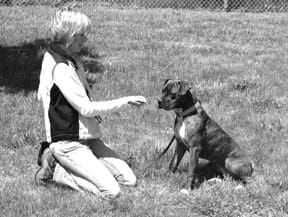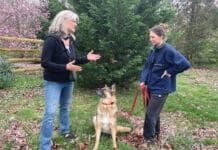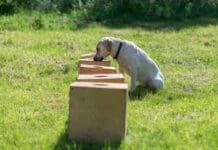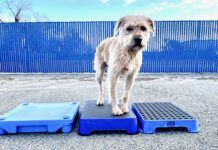When I first saw Laney, she was across the parking lot from the agility class I was teaching. Laney was a spinning, barking mass of black and white dog. Whenever the dogs in my class moved, Laney would leap in the air and start spinning and barking again. Her person, Bonnie Vogt, looked confused and distressed.

“I had no idea what I was getting myself into,” Vogt told me at a later date. She’d met Laney just a few days earlier at a dog camp. Laney was attending the camp with her foster person and Vogt took a fancy to the young dog. The attraction was obvious; Laney was athletic, smart, driven, and eager to please. It wasn’t until Vogt brought Laney home and took her to observe the agility class that Vogt discovered Laney’s somewhat crazier side.
Laney is certainly not alone in her high arousal behavior. Many dogs have something that gets them really worked-up – skateboards, cats, and bicycles are common. For Laney, it can be anything that moves, including cars, balls, or dogs running an agility course.
“Look” is a behavior that can help you manage your dog’s response in these situations. It is an especially useful behavior for dogs whose excitement is triggered, at least in part, by movement, a prey drive, or the desire to fetch or herd.
“Look” can be part of an overall program to help your dog learn to behave better in the presence of those things that make her crazy.
“It really works,” says Vogt. Today, Laney can walk politely down busy streets (with cars rushing by), past moving dogs, and even ignore skateboards. Vogt acknowledges that Laney’s success at overcoming her crazies began with the Look.
There is a lot to it
Look is a combination behavior. It is more than the “Leave it” or “Off.” It is more than the ever-popular “watch me.” It involves the dog breaking eye contact with the arousing object, person, or animal (whatever triggers the dog’s manic behavior); turning his head away from that trigger; making eye contact with you; and holding that eye contact until you give a release signal. This is a behavior that a dog can do while sitting still or moving, on leash or off. The Look is most effective when the dog learns to do all of this as soon as he notices the thing that makes him crazy – without you asking!
With a dog who gets overexcited when he sees skateboarders, for example, the Look works like this: You are walking down the street and a skateboarder comes around the corner. As soon as your dog notices the skateboarder, instead of barking and lunging, he looks at you and keeps looking until the skateboarder is past and you give the release signal. You lavish your dog with fantastic treats, praise, or attention until the skateboarder is past.
Teaching and reinforcing the Look can certainly help a dog behave better in the presence of his triggers. But there is an added benefit for dogs whose reactive behavior is also motivated by uncertainty or fear. Generously rewarding the Look may also result in counter-conditioning the scary thing, so that it becomes less scary.
Steps to training the Look
The key to being able to effectively use Look to help manage a dog who gets worked-up around dogs, skateboards, cars, cats, or anything else, is to train the behavior thoroughly before you ever use it around the things that make the dog “lose it.” Here are the steps for building a strong and reliable Look.
• Step one: Similar to “Leave it”
The first step is to teach your dog to leave something alone that he or she wants.
To begin, arm yourself with a handful of super delicious treats (such as fresh cooked chicken) and some rather boring treats (such as ordinary kibble). Put a boring treat in your left hand. Have the super good treats in a pouch, behind your back, on a table, or in some other way close at hand but not available to your dog.
Present the boring treat to your dog in a closed fist (so he or she can smell it, but can’t get to it). Allow your dog to lick, sniff, and try to get to the treat. The moment your dog backs or looks away from your closed hand a tiny bit, mark the behavior (with the word “Yes!” or the click! of a clicker, for example), and give your dog one of the top-quality treats from your other hand. Be very patient; some dogs will lick and mouth your hand for several minutes before they back off the first time.
Repeat several times until your dog immediately backs away from the treat.
Move the boring treat to your right hand and repeat the exercise.
• Step two: Make eye contact
The second step to the “Look” behavior is teaching your dog to make eye contact with you when he backs off of the treat.
Practice the step one exercise until you are confident your dog will immediately back away from a closed hand holding a treat. Now, when he backs away, instead of clicking or saying “Yes!” immediately, wait for him to glance up at your face. Then click! or say “Yes!” and give your dog one of the super-delicious treats. Once again, be patient. At first, your dog will not know that you have raised the criteria for a reward. She may go back to the hand and sniff and lick some more. Wait. The moment she looks at you to figure out what you want, click! and give her a terrific treat.
Practice this several times with the boring treat in each hand. Don’t worry if your dog is not staring into your eyes; just looking up at your face is enough.
Please note: Some dogs are not comfortable making or holding eye contact with people and have not learned that it is a rewarding behavior. For these dogs, looking at your face can be a little more difficult. If you have not already taught your dog that making eye contact with you is a valuable and rewarding behavior, practice it separately from this exercise. Try taking a treat and bringing it up to your eye. When your dog follows the treat and looks at your face, click! or say “Yes!” and reward with a treat.
• Step three: Put it on cue
At this point, your dog will probably start “offering” you the look without you asking; this is great! In the long run, you will want to continue reinforcing the offered or automatic look. (See step six, below, for more on the automatic look.) But teaching your dog to respond to the Look cue when you ask can also be helpful.
You are ready to put the behavior on cue once your dog has the idea of looking away from the treat and into your eyes. Immediately before you present the fist with the boring treat, say “Look!” After he associates the word with the action, you can present the fist first, then say, “Look!”
A fun and added benefit of using the word “look” instead of something more common like “leave it” or “off” is that it is an easy word to slip into normal sentences. Think how impressed your neighbors will be when you can walk down the sidewalk and say to your dog, “Now don’t even LOOK at that kitty,” and he whips his head around and pays attention to you instead of the cat!
• Step four: Make it more difficult
Once your dog can easily look away from a temptation and hold eye contact with you for about 10 seconds, raise your criteria in two ways: increase the length of time your dog holds eye contact, and increase the level of temptation offered by the thing he is supposed to be resisting.
Start this latter process by having your dog resist the temptation of very attractive treats, by having him look away from treats in an open palm, or by having him look away from a treat on the floor. You can work with different items, too. Practice with boring objects (such as a hat or towel) and gradually build up to more exciting objects (like his favorite toy or a ball). Practice with things your dog would normally want to investigate, such as trees he’d like to sniff when you are on walks. For your dog to get really good, you may need to practice with as many as 30 or more different items.
Increase the length of time your dog needs to hold eye contact, too. At first, mark the desired behavior with a click! or “Yes!” and give him a treat for just glancing at your face, then for holding it for a half a second, then a whole second, then two seconds, etc. Work up to a minute or longer.
Practice each of these increasingly demanding criteria separately. If you work on the length of time, use a boring treat in a closed fist. If you work on a more difficult object (like a better treat in an open palm), click at first for simply looking away, then for making eye contact, and then for holding the eye contact. Then put them together and practice with more difficult objects for longer periods of time.
At this point, start varying the rewards, giving less interesting treats for easier responses, and better treats for more difficult responses. Note: Do not yet practice with the thing that makes your dog crazy!
• Step five: Vary locations, positions
Practice in different locations and with your dog in different positions, by setting up practice sessions in new places. Also practice with various levels of distraction. Again, start with the easier distractions and then make it more difficult.
Practice with your dog in different positions, too: in front of you, next to you, on either side, standing, sitting, or walking.
Practice both on leash and off leash. At first, do off-leash practice with items that are easier to resist or with some type of “safety” in place (like a screen over the top of a bowl) so that your dog cannot get the treats or toys you are practicing with.
Try setting up a Look “course” where you have multiple items such as treats, toys, and odd objects set around your yard or the park. Include people and other dogs, too. Walk your dog past and around each object, person, or animal.
• Step six: The automatic look
The automatic response is part of what makes Look a powerful behavior. At various points while training this, your dog will most likely “offer” the look without your “asking.” This is GREAT and should be rewarded generously, with the best treats possible, and with jackpots (rapidly feeding 10 or more treats). You want your dog to volunteer the Look any time he is unsure of himself.
Practice this behavior around a variety of items, some easier and some more difficult to resist. With enough practice, the Look will become one of the things your dog does when he doesn’t know what else to do! You’ll soon find that your dog will automatically look at you when he spots a former trigger; notice and reward this!
Trying it in the real world
Be sure your dog is ready to begin practicing in the presence of the thing that makes your dog crazy by testing him with different objects in different locations first. Make sure he can offer the Look in the presence of many different triggers, in many locations, and while in different positions. You want him to really understand this behavior, and have it well generalized, before practicing with the thing that makes your dog crazy.
To set up your dog for success, arrange your practice sessions so that you can control the distance between your dog and his trigger. At first, practice with the thing that makes your dog crazy far enough away that your dog doesn’t actually get worked-up. Practice repeatedly so that your dog automatically looks at you every time he sees his former trigger.
Use the absolute best rewards possible. This is the time to bring out the roast beef, smelly sardines, or canned chicken.
Gradually (over several practice sessions or possibly over several weeks of practice) move your dog closer and closer until he can do the behavior with the thing that makes him crazy within a few feet.
Continue watching for those “offered” Looks. Reward generously and give jackpots. This helps your dog learn that he can disengage on his own and that you will notice and appreciate it!
“Look” is a great foundation
I’ve seen the Look work wonders with many dogs, including Laney and one of my own dogs. I’ve watched dogs with high prey drive learn to ignore cats and squirrels and look at their handlers instead. I’ve known dogs who would like to chase joggers, skateboarders, and bicyclists learn to Look instead of lunge. I’ve watched dogs who are reactive with other dogs learn to walk through groups of strange dogs while looking at their person.
Look is a powerful foundation tool for managing high-arousal problems. When a dog can Look reliably when asked and offers the behavior in the face of potentially arousing stimuli, he is well on his way to learning calm behavior in any situation.






